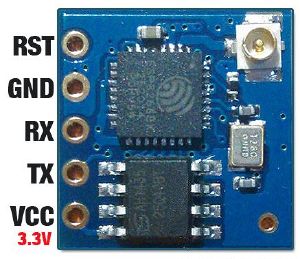ESP-05
10:54, 28 rugsėjo 2021 versija, sukurta \dev\null (Aptarimas | indėlis) (Naujas puslapis: miniatiūra <pre> ESP8266 ESP-05 WiFi Transceiver Module The 5 pin version of the ESP8266 Esp-05 WiFi module has the fol...)
ESP8266 ESP-05 WiFi Transceiver Module The 5 pin version of the ESP8266 Esp-05 WiFi module has the following connections on the 5 pin header: Reset - active low reset (apply low voltage level to reset), EXT_RSTB pin 32 on ESP8266 chip GND - GND or 0V of power supply Rx - UART receive pin (3.3V logic level) Tx - UART transmit pin (3.3V logic level) Vcc - 3.3V power supply Vcc connection There is an antenna connector at the top left of the board for an external aerial/antenna. An additional GND connection can be found at the top right of the board. Operating Voltage The ESP8266 chip and ESP-05 module operate at a voltage of 3.3V (working range is 3.0V to 3.6V). I/O pins including the UART pins operate with 3.3V logic. The chip and module I/O and UART pins are NOT 5V tolerant. Current Consumption An operating current average value of 80mA is given for the EXP8266 chip in the datasheet. The ESP8266 SDK getting started guide gives the following note for their evaluation board modules: The ESP8266 Wi-Fi module needs 3.3V power supply and may draw current in the order of 500mA. Note that this current value is for the Espressif modules and not the ESP-05, but it does give some idea of the current that some modules can draw. The following current consumption values are for the EXP8266 chip when transmitting and receiving. These are the highest typical values from the datasheet. Transmit Current: highest typical current consumption of 170mA under the following conditions (Tx802.11b, CCK 11Mbps, P OUT=+17dBm) Receive Current: highest typical current consumption of 56mA under the following conditions (Rx 802.11g, 1024 bytes packet length, -70dBm) Espressif ESP8266 Chip Information Further information on the ESP8266EX chip used on the ESP-05 module can be found on the Espressif ESP8266EX resource page. Test the ESP8266 ESP-05 WiFi Transceiver Module using the article on ESP8266 testing shows how to perform some basic tests on the Esp-05 module to see if it is working. An Arduino is used to do the testing.
Arduino UNO
Sujungimas
- Arduino 3.3V -> VCC
- Arduino Digital 2 -> TX
- Arduino Digital 3 -> RX
- Arduino GND -> GND
Patikrinimas
#include <SoftwareSerial.h>
#define DEBUG true
String readStr;
// Nustatymai
//TX pin 2, RX pin 3
SoftwareSerial esp8266(2, 3);
void setup() {
Serial.begin(115200);
esp8266.begin(115200);
delay(100);
esp8266.println("AT");
while (!esp8266.available()) { };
readStr = esp8266.readString();
Serial.print("Echo:" + readStr);
if ( readStr.indexOf("OK") > -1) {
Serial.println("AT Command Connection : OK");
};
}
void loop() {
}
